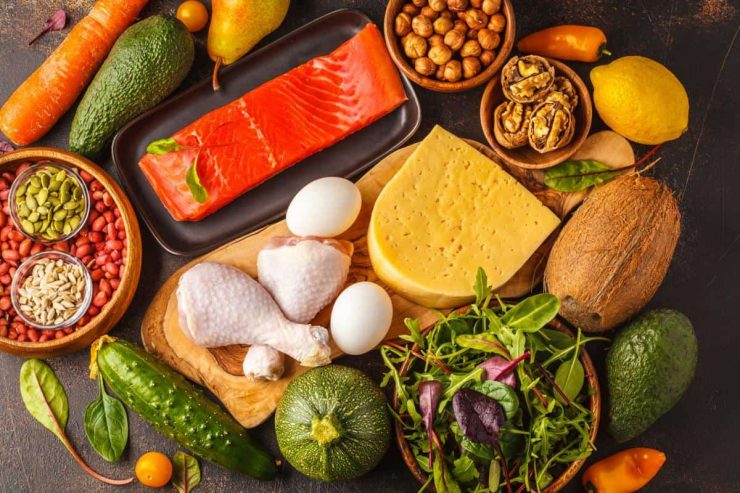Lately, there is a lot of hype around the keto diet but what is the
The main take away of the
When your body is put into ketosis, it becomes efficient at burning fat for energy instead of carbs. It also turns fat into ketones in the liver, which can supply power to your brain. Being on a
With that being said, there are a few different types of ketogenic diets. Here are the four most popular.
Standard Ketogenic Diet (SKD)
The standard ketogenic diet is low-carb, with moderate-protein, and high-fat. You can break it down to being 75% fat, 20% protein, and only 5% of carbs.
Cyclical Ketogenic Diet (CKD)
With the cyclical ketogenic diet, your diet includes periods of higher-carb refeeds, like five ketogenic days followed by two high-carb days.
Targeted Ketogenic Diet (TKD)
The main point of the targeted ketogenic diet is for those who work out often. What it allows you to do is add carbs around your workout.
High-Protein Ketogenic Diet
The high-protein ketogenic diet is like the standard ketogenic diet, but instead, it includes more protein. Your day would often involve 60% fat, 35% protein, and 5% carbs.
Although there are four known keto diets, only the standard ketogenic diet and the high-protein ketogenic diet have been extensively studied. The cyclical and targeted ketogenic diets are more advanced methods of the diet and are typically used by bodybuilders or athletes.
Foods to Avoid – A Beginners Guide to the Keto Diet
When it comes to the keto diet, there are a variety of foods you need to avoid. The point of the keto diet is to eat healthy fats, not fats that will only add to your weight gain or health issues. Here are a few foods you need to avoid when doing a keto diet.
Sugary Foods: Foods or drinks like soda, fruit juices, smoothies, cakes, and ice cream are all restrictive on a keto diet.
Grains or Starches: Wheat-based products, rice, pasta, and cereal cannot be consumed when trying to reach a state of ketosis.
Fruit: Believe it or not, the fruit is highly restrictive when it comes to a keto diet. Small portions of berries are allowed.
Beans or Legumes: Although they are high in protein, peas, kidney beans, lentils, and chickpeas are just some of the bean and legumes that you cannot consume.
Root Vegetables: Potatoes, sweet potatoes, carrots, and parsnips are some of the vegetables that aren’t allowed on a keto diet.
Other restrictions include low-fat or diet products, condiments or sauces, unhealthy fats like vegetable oils, alcohol, and sugar-free diet foods.
Foods You Can Eat
The list of foods that are restricted on a keto diet is extensive, but there are tons of food you can eat when on the keto diet.
Meat: Red meat, steak, ham, bacon, chicken, and turkey are just some of the meat you can eat on a keto diet.
Fatty Fish: Fish like salmon, trout, and tuna are great to include in your keto diet.
Eggs and Butter: Both eggs and butter are high in fat. Look for eggs that have omega-3 and grass-fed butter or cream.
Cheese: Oh yea, you can eat cheese. Unprocessed cheese like cheddar, goat, cream, blue and mozzarella can be added into your diet.
Nuts or Seeds: Almonds, walnuts, flaxseed, pumpkin seeds, chia seeds are all great fats to add to your diet.
Other great foods to include in your diet are healthy oils, avocados, low-carb veggies like peppers or green vegetables, and condiments like salt, pepper, and healthy herbs.
Keto Diet Side Effects – A Beginners Guide to the Keto Diet
There are side effects when it comes to starting a ketogenic diet. The most known side effect is called the keto flu, and usually it only lasts a few days. The keto flu includes low energy and mental functions, increased hunger, sleep issues, nausea, digestive discomfort, and decreased exercise performance.
A ketogenic diet can also change the water and mineral balance in your body. Adding extra salt to your meals or taking a mineral supplement can help with that.
When starting a keto diet, it is essential to remember to eat until you’re full and don’t restrict your calories too much. A keto diet will help you lose weight without intentionally calorie restrictions.
Also, remember that a keto diet is excellent, but it might not be for everyone. If you’re an athlete, attempting to add muscle or weight, then this diet might not work out for you.
With any diet, you must work within the plan and be consistent to see the long-term effects of it. Before starting a keto diet, you may want to talk with a doctor to make sure it is a good option for you.
This article originally appeared on AboutZenLife.com.




